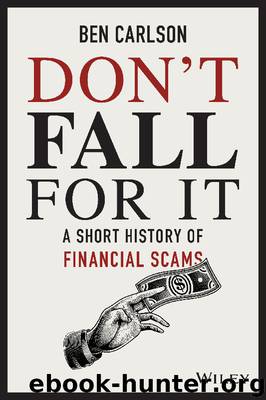Don't Fall For It by Ben Carlson

Author:Ben Carlson
Language: eng
Format: epub
ISBN: 9781119605188
Publisher: Wiley
Published: 2019-11-19T12:00:00+00:00
The Railway Napoleon
Technological innovation isn’t a prerequisite for fraud to occur, but it sure makes it a whole lot easier. Innovation breeds change, change breeds emotion, and emotion adds fuel to the fire when money is involved. There’s a reason financial bubbles are often called manias – they elicit heightened levels of energy, excitement, and activity. Hucksters are drawn to financial manias like a millennial to avocado toast because it’s easier to deceive people when they think humanity is entering a “new era” or “paradigm shift.” Self-promoters take their hubris to another level to prey on the greed of others during these times. George Hudson saw the British railway bubble of the mid-nineteenth century as an opportune time to profit from the excitement in the air. There was a wave of innovation taking place, and the emotions of the crowd who were looking to get rich quickly led to one of the more underrated historical bubbles on record.
Like most bubbles, the railway mania actually started out as a good idea that was simply taken too far by investors and those selling railway projects alike. The first commuter trains appeared in the United Kingdom during the 1820s. They traveled just 12.5 miles per hour, which reduced the trip from London to Glasgow to 24 hours. The Railway Times asked, without even a hint of sarcasm, “What more could any reasonable man want?”[4] The first railway mania hit in 1825 with the opening of the first steam railway. An economic downturn snuffed out any speculation and by 1840, shares of the main railway companies were selling at a discount to their issue price (stocks acted more like bonds than stocks back then). There were 2,000 miles of track completed at this point, which led some to speculate whether the national railway system in Britain was already finished.[5]
Memories are short when people think there’s money to be made so this first mini-mania in railway stocks became a distant memory by the summer of 1842. That’s when Prince Albert of the Royal Family persuaded Queen Victoria to take her first train ride. That was the all-clear investors needed to hop aboard the train that was railway stocks. By 1844, investors viewed railway stocks as safe and secure with huge upside potential. It didn’t take long for that cautious optimism to morph into reckless speculation.[6]
George Hudson was one of the original modern capitalists, using publicity, salesmanship, and a cult of personality to attract enormous amounts of capital and goodwill from the public. Best described by his contemporaries as energetic, abrasive, bullying, penny-pinching, rule-bending, and overweight, Hudson was a shrewd businessman who knew how to persuade people to do what was best for him and his companies.[7] Innovation helped trains travel farther distances and carry heavier loads, so Hudson pounced on the opportunity by creating his own line of railways in the 1830s. Through a series of consolidations, mergers, schemes, bribes, acquisitions, and an uncanny ability to sell, his railways consolidated more power than any other in the railway industry, eventually creating the largest railway company in Britain.
Download
This site does not store any files on its server. We only index and link to content provided by other sites. Please contact the content providers to delete copyright contents if any and email us, we'll remove relevant links or contents immediately.
The Black Swan by Nassim Nicholas Taleb(6762)
Bad Blood by John Carreyrou(6274)
Pioneering Portfolio Management by David F. Swensen(6078)
Millionaire: The Philanderer, Gambler, and Duelist Who Invented Modern Finance by Janet Gleeson(4092)
Skin in the Game by Nassim Nicholas Taleb(3965)
The Money Culture by Michael Lewis(3844)
Bullshit Jobs by David Graeber(3826)
Skin in the Game: Hidden Asymmetries in Daily Life by Nassim Nicholas Taleb(3720)
The Wisdom of Finance by Mihir Desai(3523)
Blockchain Basics by Daniel Drescher(3327)
Liar's Poker by Michael Lewis(3220)
The Intelligent Investor by Benjamin Graham Jason Zweig(2930)
Hands-On Machine Learning for Algorithmic Trading by Stefan Jansen(2925)
Mastering Bitcoin: Programming the Open Blockchain by Andreas M. Antonopoulos(2890)
Fooled by Randomness: The Hidden Role of Chance in Life and in the Markets by Nassim Nicholas Taleb(2860)
Investing For Dummies by Eric Tyson(2791)
The Power of Broke by Daymond John(2770)
Market Wizards by Jack D. Schwager(2538)
Zero Hour by Harry S. Dent Jr. & Andrew Pancholi(2531)
